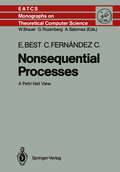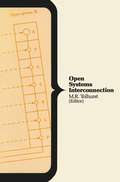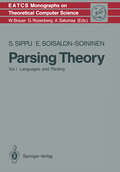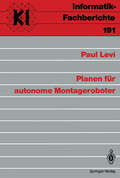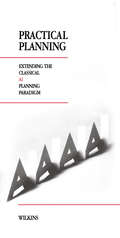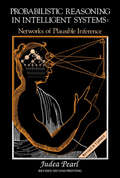- Table View
- List View
Nonsequential Processes: A Petri Net View (Monographs in Theoretical Computer Science. An EATCS Series #13)
by Eike Best Cesar Fernandez C.The theory of Petri nets is a part of computer science whose importance is increasingly acknowledged. Many papers and anthologies, whose subject matter is net theory and its applications, have appeared to date. There exist at least seven introductory textbooks on the theory. The present monograph augments this literature by offering a mathematical treatment of one of the central aspects of net theory: the modelling of concur rency by partially ordered sets. Occurrence nets - which are special nets as well as special partial orders - are proposed by net theory for this purpose. We study both the general properties of occurrence nets and their use in describing the concurrent behaviour of systems. Occurrence nets may be contrasted with a more language-oriented approach to the modelling of concurrency known as arbitrary interleaving. We will dis cuss some connections between these' two approaches. Other approaches based on partially ordered sets - such as the theory of traces, the theory of event structures and the theory of semi words - are not considered in this book, in spite of the strong links between them and net theory.
Open Systems Interconnection (Computer Science Series)
Written by a team of software engineers at Admiral Computing Group, this book will appeal both to students of computer systems and to practising engineers. It provides a comprehensive overview of the OSI model and its layers.
Optical Channels: Fibers, Clouds, Water, and the Atmosphere (Applications of Communications Theory)
by Sherman Karp Robert M. Gagliardi Steven E. Moran Lawrence B. StottsWhen we were first approached by Dr. Lucky to write this book we were very enthusiastic about the prospect, since we had contemplated a similar project for quite some time. The difficulty lay in how best to digest the vast amount of data on optical propagation, reduce it to a book of manageable size, and simultaneously form the transition from the physics of propagation to the engineering of optical channels. This is the intent of Optical Channels. In accomplishing our goal it was necessary to condense the material on optical propagation and, in so doing, we have left a large amount to be handled via references. We have tried to make these decisions in a consistent manner so that the book will be uniform in its treatment of this topic. We identify four channels for consideration: the free-space channel, which: is characteristic of a tranquil atmosphere or a space-to-space link; the turbulent channel, which is characteristic of the atmospheric channel; the scatter channel in two forms, clouds and water; and the fiber optic channel. For each of these channels we have tried to reduce the applicable propagation theory to a level that can be used for engineering design. This has been done by example, but here again decisions had to be made on which examples to present. We have not tried to present any material on optical components and consequently other references on engineering would be necessary to supplement this book.
Optimization, Parallel Processing and Applications: Proceedings of the Oberwolfach Conference on Operations Research, February 16–21, 1987 and the Workshop on Advanced Computation Techniques, Parallel Processing and Optimization Held at Karlsruhe, West Germany, February 22–25, 1987 (Lecture Notes in Economics and Mathematical Systems #304)
by Alexander Kurzhanski Klaus Neumann Diethard PallaschkeParallel Computation and Computers for Artificial Intelligence (The Springer International Series in Engineering and Computer Science #26)
by J. S. KowalikIt has been widely recognized that artificial intelligence computations offer large potential for distributed and parallel processing. Unfortunately, not much is known about designing parallel AI algorithms and efficient, easy-to-use parallel computer architectures for AI applications. The field of parallel computation and computers for AI is in its infancy, but some significant ideas have appeared and initial practical experience has become available. The purpose of this book has been to collect in one volume contributions from several leading researchers and pioneers of AI that represent a sample of these ideas and experiences. This sample does not include all schools of thought nor contributions from all leading researchers, but it covers a relatively wide variety of views and topics and in this sense can be helpful in assessing the state ofthe art. We hope that the book will serve, at least, as a pointer to more specialized literature and that it will stimulate interest in the area of parallel AI processing. It has been a great pleasure and a privilege to cooperate with all contributors to this volume. They have my warmest thanks and gratitude. Mrs. Birgitta Knapp has assisted me in the editorial task and demonstrated a great deal of skill and patience. Janusz S. Kowalik vii INTRODUCTION Artificial intelligence (AI) computer programs can be very time-consuming.
Parallel Programming and Compilers (The Springer International Series in Engineering and Computer Science #59)
by Constantine D. PolychronopoulosThe second half of the 1970s was marked with impressive advances in array/vector architectures and vectorization techniques and compilers. This progress continued with a particular focus on vector machines until the middle of the 1980s. The major ity of supercomputers during this period were register-to-register (Cray 1) or memory-to-memory (CDC Cyber 205) vector (pipelined) machines. However, the increasing demand for higher computational rates lead naturally to parallel comput ers and software. Through the replication of autonomous processors in a coordinated system, one can skip over performance barriers due technology limitations. In princi ple, parallelism offers unlimited performance potential. Nevertheless, it is very difficult to realize this performance potential in practice. So far, we have seen only the tip of the iceberg called "parallel machines and parallel programming". Parallel programming in particular is a rapidly evolving art and, at present, highly empirical. In this book we discuss several aspects of parallel programming and parallelizing compilers. Instead of trying to develop parallel programming methodologies and paradigms, we often focus on more advanced topics assuming that the reader has an adequate background in parallel processing. The book is organized in three main parts. In the first part (Chapters 1 and 2) we set the stage and focus on program transformations and parallelizing compilers. The second part of this book (Chapters 3 and 4) discusses scheduling for parallel machines from the practical point of view macro and microtasking and supporting environments). Finally, the last part (Le.
Parallelrechner-Architekturen: Ansätze für imperative und deklarative Sprachen
by Rudolf KoberParallelrechner-Architekturen zeigen den Weg zu hochleistungsfähigen, kostengünstigen Rechnerstrukturen. Um ihr Leistungspotential für möglichst breite Anwendungsbereiche einfach und wirkungsvoll nutzbar zu machen, müssen Rechnerarchitektur und Softwarearchitektur einschließlich der Programmiersprachen gemeinsam betrachtet und im Einklang miteinander entwickelt werden. In diesem Buch werden Aspekte der Parallelverarbeitung bei modernen imperativen und deklarativen Sprachen dargestellt, daraus resultierende Anforderungen an parallele Systemarchitekturen abgeleitet sowie geeignete Architekturen vorgestellt und bewertet. Im einzelnen werden behandelt: imperative Sprachen (prozedurale und objekt-orientierte), deklarative Sprachen (funktionale und logische), Ebenen der Parallelität, Granularität der Verarbeitungspakete, explizite und implizite Parallelität, Anforderungen an Kommunikation und Synchronisation, Prozeß- und Speicherverwaltung, abstrakte Maschinen, Konzepte für die Umsetzung der abstrakten Maschinen in physikalische Architekturen sowie bekannte Realisierungen.
Parsing Theory: Volume I Languages and Parsing (Monographs in Theoretical Computer Science. An EATCS Series #15)
by Seppo Sippu Eljas Soisalon-SoininenThe theory of parsing is an important application area of the theory of formal languages and automata. The evolution of modem high-level programming languages created a need for a general and theoretically dean methodology for writing compilers for these languages. It was perceived that the compilation process had to be "syntax-directed", that is, the functioning of a programming language compiler had to be defined completely by the underlying formal syntax of the language. A program text to be compiled is "parsed" according to the syntax of the language, and the object code for the program is generated according to the semantics attached to the parsed syntactic entities. Context-free grammars were soon found to be the most convenient formalism for describing the syntax of programming languages, and accordingly methods for parsing context-free languages were devel oped. Practical considerations led to the definition of various kinds of restricted context-free grammars that are parsable by means of efficient deterministic linear-time algorithms.
Partial Differential Operators: Proceedings of ELAM VIII, held in Rio de Janeiro, July 14-25, 1986 (Lecture Notes in Mathematics #1324)
by Fernando A. Cardoso Djairo G. De Figueiredo Rafael Iorio Orlando LopesThe Latin American School of Mathematics (ELAM) is one of the most important mathematical events in Latin America. It has been held every other year since 1968 in a different country of the region, and its theme varies according to the areas of interest of local research groups. The subject of the 1986 school was Partial Differential Equations with emphasis on Microlocal Analysis, Scattering Theory and the applications of Nonlinear Analysis to Elliptic Equations and Hamiltonian Systems.
Personal Computer in Labor, Versuchs- und Prüffeld: Der PC als Hilfsmittel bei der Erfassung, Verarbeitung und Darstellung von Meßdaten
by Harald SchumnyPhilosophy, Language, and Artificial Intelligence: Resources for Processing Natural Language (Studies in Cognitive Systems #2)
by Jack Kulas, James H. Fetzer and Terry L. RankinThis series will include monographs and collections of studies devoted to the investigation and exploration of knowledge, information and data-processing systems of all kinds, no matter whether human, (other) animal or machine. Its scope is intended to span the full range of interests from classical problems in the philosophy of mind and phi losophical psychology through issues in cognitive psychology and socio biology (concerning the mental capabilities of other species) to ideas related to artificial intelligence and computer science. While primary emphasis will be placed upon theoretical, conceptual and epistemologi cal aspects of these problems and domains, empirical, experimental and methodological studies will also appear from time to time. Among the most challenging and difficult projects within the scope of artificial intelligence is the development and implementation of com puter programs suitable for processing natural language. Our purpose in compiling the present volume has been to contribute to the foundations of this enterprise by bringing together classic papers devoted to crucial problems involved in understanding natural language, which range from issues of formal syntax and logical form to those of possible-worlds and situation semantics. The book begins with a comprehensive introduc tion composed by Jack Kulas, the senior editor of this work, which pro vides a systematic orientation to this complex field, and ends with a selected bibliography intended to promote further research. If our efforts assist others in dealing with these problems, they will have been worthwhile. J. H. F.
Planen für autonome Montageroboter (Informatik-Fachberichte #191)
by Paul LeviDas Buch behandelt die Robotik aus der Sicht der Künstlichen Intelligenz (KI) sowohl für einen einzelnen Roboter als auch für Roboterverbände (verteilte KI). Dieser Ansatz ist neuartig, da bislang die Roboterbücher diese Disziplin klassisch beschrieben haben (z.B. Transformation zwischen Gelenkwinkeln). Diese erste systematische Darstellung der wissensbasierten Planung und ihrer Bewertung ist mit einer detaillierten Beschreibung zukünftiger Planungseinsätze verbunden. Die neuen Techniken der Expertensysteme und der KI (z.B. Bedingungsausbreitung, Meinungswartung, verteiltes Planen) und ihre Eignung für die Roboterplanung werden ausführlich behandelt. Das Ziel dieses Buches ist es, einen umfassenden Zugang für den Aufbau autonomer und möglicherweise mobiler Systeme (Roboter, Fahrzeuge) zu liefern. Der Leser dieses Buches findet zahlreiche Anregungen, sich selbst mit weiteren Detailfragen auseinanderzusetzen, die beim Aufbau solcher autonomen Systeme notwendig sind. Die Robotik wird als eine integrierende Disziplin verstanden, die viele lose Enden (Informatik, Maschinenbau, E-Technik etc.) zu einem funktionsfähigen Gebilde verknüpfen muß.
Possibility Theory: An Approach to Computerized Processing of Uncertainty
by Didier Dubois Henri PradeIn the evolution of scientific theories, concern with uncertainty is almost invariably a concomitant of maturation. This is certainly true of the evolution· of physics, economics, operations research, communication sciences, and a host of other fields. And it is true of what has been happening more recently in the area of artificial intelligence, most notably in the development of theories relating to the management of uncertainty in knowledge-based systems. In science, it is traditional to deal with uncertainty through the use of probability theory. In recent years, however, it has become increasingly clear that there are some important facets of uncertainty which do not lend themselves to analysis by classical probability-based methods. One such facet is that of lexical elasticity, which relates to the fuzziness of words in natural languages. As a case in point, even a simple relation X, Y, and Z, expressed as if X is small and Y is very large then between Z is not very small, does not lend itself to a simple interpretation within the framework of probability theory by reason of the lexical elasticity of the predicates small and large.
A PostScript Cookbook
by Barry ThomasThis book examines POSTSCRIPT, the trademark of Adobe Corporation, USA, which is a computer language for controlling printers. The text provides information on what it is and how it works. The use of text, graphics and fonts are included.
Potential Theory
by Josef Kral Jaroslav Lukes Ivan Netuka Jiri VeselyWithin the tradition of meetings devoted to potential theory, a conference on potential theory took place in Prague on 19-24, July 1987. The Conference was organized by the Faculty of Mathematics and Physics, Charles University, with the collaboration of the Institute of Mathematics, Czechoslovak Academy of Sciences, the Department of Mathematics, Czech University of Technology, the Union of Czechoslovak Mathematicians and Physicists, the Czechoslovak Scientific and Technical Society, and supported by IMU. During the Conference, 69 scientific communications from different branches of potential theory were presented; the majority of them are in cluded in the present volume. (Papers based on survey lectures delivered at the Conference, its program as well as a collection of problems from potential theory will appear in a special volume of the Lecture Notes Series published by Springer-Verlag). Topics of these communications truly reflect the vast scope of contemporary potential theory. Some contributions deal with applications in physics and engineering, other concern potential theoretic aspects of function theory and complex analysis. Numerous papers are devoted to the theory of partial differential equations. Included are also many articles on axiomatic and abstract potential theory with its relations to probability theory. The present volume may thus be of intrest to mathematicians speciali zing in the above-mentioned fields and also to everybody interested in the present state of potential theory as a whole.
Practical Planning: Extending the Classical AI Planning Paradigm
by David E. WilkinsPlanning, or reasoning about actions, is a fundamental element of intelligent behavior--and one that artificial intelligence has found very difficult to implement. The most well-understood approach to building planning systems has been under refinement since the late 1960s and has now reached a level of maturity where there are good prospects for building working planners.Practical Planning is an in-depth examination of this classical planning paradigm through an intensive case study of SIPE, a significantly implemented planning system. The author, the developer of SIPE, defines the planning problem in general, explains why reasoning about actions is so complex, and describes all parts of the SIPE system and the algorithms needed to achieve efficiency. Details are discussed in the context of problems and important issues in building a practical planner; discussions of how other systems address these issues are also included.Assuming only a basic background in AI, Practical Planning will be of great interest to professionals interested in incorporating planning capabilities into AI systems.
Probabilistic Reasoning in Intelligent Systems: Networks of Plausible Inference
by Judea PearlProbabilistic Reasoning in Intelligent Systems is a complete and accessible account of the theoretical foundations and computational methods that underlie plausible reasoning under uncertainty. The author provides a coherent explication of probability as a language for reasoning with partial belief and offers a unifying perspective on other AI approaches to uncertainty, such as the Dempster-Shafer formalism, truth maintenance systems, and nonmonotonic logic.The author distinguishes syntactic and semantic approaches to uncertainty--and offers techniques, based on belief networks, that provide a mechanism for making semantics-based systems operational. Specifically, network-propagation techniques serve as a mechanism for combining the theoretical coherence of probability theory with modern demands of reasoning-systems technology: modular declarative inputs, conceptually meaningful inferences, and parallel distributed computation. Application areas include diagnosis, forecasting, image interpretation, multi-sensor fusion, decision support systems, plan recognition, planning, speech recognition--in short, almost every task requiring that conclusions be drawn from uncertain clues and incomplete information.Probabilistic Reasoning in Intelligent Systems will be of special interest to scholars and researchers in AI, decision theory, statistics, logic, philosophy, cognitive psychology, and the management sciences. Professionals in the areas of knowledge-based systems, operations research, engineering, and statistics will find theoretical and computational tools of immediate practical use. The book can also be used as an excellent text for graduate-level courses in AI, operations research, or applied probability.
Probability, Random Processes, and Ergodic Properties
by Robert M. GrayThis book has been written for several reasons, not all of which are academic. This material was for many years the first half of a book in progress on information and ergodic theory. The intent was and is to provide a reasonably self-contained advanced treatment of measure theory, prob ability theory, and the theory of discrete time random processes with an emphasis on general alphabets and on ergodic and stationary properties of random processes that might be neither ergodic nor stationary. The intended audience was mathematically inc1ined engineering graduate students and visiting scholars who had not had formal courses in measure theoretic probability . Much of the material is familiar stuff for mathematicians, but many of the topics and results have not previously appeared in books. The original project grew too large and the first part contained much that would likely bore mathematicians and dis courage them from the second part. Hence I finally followed the suggestion to separate the material and split the project in two. The original justification for the present manuscript was the pragmatic one that it would be a shame to waste all the effort thus far expended. A more idealistic motivation was that the presentation bad merit as filling a unique, albeit smaIl, hole in the literature.
Probleme und Lösungen mit Turbo-Prolog: Logikaufgaben Sortierprogramme Auswerfen von Datenbanken Variationen von Bäumen (Programmieren von Mikrocomputern #28)
by Dietmar HerrmannProceedings of the Third International Conference on Data and Knowledge Bases: Improving Usability and Responsiveness
by C. Beeri J. W. Schmidt U. DayalProceedings of the Third International Conference on Data and Knowledge Bases: Improving Usability and Responsiveness compiles papers presented at the Third International Conference on Data and Knowledge Bases held in Jerusalem, Israel on June 28-30, 1988.This book discusses the management system for graph-like documents, selection of processing strategies for different recursive queries, and supporting concurrent access to facts in logic programs. The design considerations for a Prolog database engine, experience with the domain algebra, and two level transaction management in a multiprocessor database machine are also described. This publication likewise covers the non-deterministic choice in Datalog and locally balanced compact Trie Hashing.This compilation is a good source for researchers and specialists of disciplines related to computer science.
Programmieren mit FORTH: Übersetzt und bearbeitet von Peter Monadjemi (Programmieren von Mikrocomputern #37)
by C. Kevin MacCabeProgrammiermethoden der Künstlichen Intelligenz: Band 1 (Studienreihe Informatik)
by Herbert StoyanDas vorliegende Buch ist eine Einführung in die wesentlichen Problembereiche der KI-Programmierung. Dabei dienen Sprachentwicklung, -implementierung und -benutzung als neuartige einheitliche Sichtweise. Die Grundidee ist, daß jedem Problem ein angepaßtes Verarbeitungsmodell (eine abstrakte Maschine) entspricht, das gefunden und mit Hilfe einer zugeordneten Programmiersprache operabel gemacht werden kann. Programmiersprachen können jedoch auch uminterpretiert werden, indem ihnen konzeptionell ein neues Verarbeitungsmodell zugrundegelegt wird. Diese Ausdrucksvielfalt führt zu verschiedenen "Programmierstilen". Um den angehenden KI-Programmierer zu befähigen, mit KI-Programmiersprachen (Wissensrepräsentationsformalismen) umzugehen, sie zu verstehen und zu implementieren, wird eine Reihe von etablierten bzw. zeitweise wichtigen Sprachen dargestellt. Das Besondere an diesem Sprachspektrum ist die Vielfalt der Verarbeitungsmodelle, auf denen die Sprachen beruhen, und die Unterschiedlichkeit der Programmierstile, denen der Programmierer folgen kann. Im vorliegenden 1. Band werden Funktions-, Muster-, Operator- und Logik-orientierte Formen der Programmierung behandelt und an einem durchgehenden Problembeispiel vorgestellt. Im 2. Band werden moderne Konzepte und Methoden im Vordergrund stehen.
